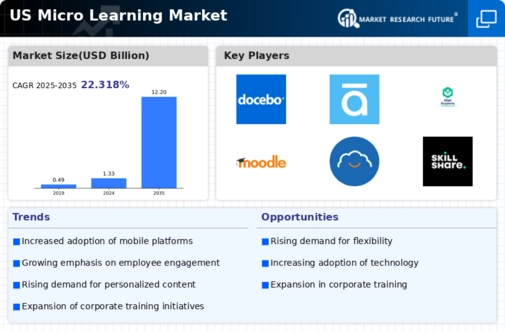The micro learning market in the US is characterized by a dynamic competitive landscape, driven by the increasing demand for flexible and efficient learning solutions. Key players such as LinkedIn Learning (US), Udemy (US), and Coursera (US) are at the forefront, each adopting distinct strategies to enhance their market positioning. LinkedIn Learning (US) focuses on integrating its platform with professional networking capabilities, thereby leveraging its vast user base to offer personalized learning experiences. In contrast, Udemy (US) emphasizes a diverse course catalog, appealing to a broad audience by enabling instructors to create and monetize their content. Coursera (US) has positioned itself as a leader in partnerships with universities, offering accredited courses that cater to both individual learners and corporate clients, thus enhancing its credibility and reach.
The business tactics employed by these companies reflect a moderately fragmented market structure, where competition is intense yet varied. Localizing content to meet regional needs and optimizing digital delivery channels are common strategies. The collective influence of these key players shapes the market, as they continuously innovate to capture the attention of learners seeking bite-sized educational content. This competitive environment fosters a culture of rapid adaptation, where companies must remain agile to respond to evolving consumer preferences.
In October 2025, LinkedIn Learning (US) announced a strategic partnership with a leading AI firm to enhance its content recommendation algorithms. This move is significant as it aims to provide users with more tailored learning paths, potentially increasing user engagement and retention. By leveraging AI, LinkedIn Learning (US) seeks to differentiate itself in a crowded market, aligning its offerings with the growing trend of personalized learning experiences.
In September 2025, Udemy (US) launched a new initiative aimed at expanding its corporate training solutions, targeting small to medium-sized enterprises (SMEs). This initiative is crucial as it addresses the specific needs of SMEs, which often lack access to comprehensive training resources. By focusing on this segment, Udemy (US) not only broadens its market reach but also positions itself as a key player in the corporate training landscape, potentially increasing its revenue streams.
In August 2025, Coursera (US) introduced a subscription model for its enterprise clients, allowing organizations to access a wide range of courses for a fixed fee. This strategic shift is indicative of a broader trend towards flexible pricing models in the education sector. By offering a subscription service, Coursera (US) enhances its value proposition to businesses, making it easier for them to invest in employee development while ensuring a steady revenue flow for the company.
As of November 2025, the micro learning market is increasingly defined by trends such as digitalization, AI integration, and a focus on sustainability. Strategic alliances among key players are shaping the competitive landscape, fostering innovation and collaboration. Looking ahead, it appears that competitive differentiation will increasingly hinge on technological advancements and the ability to deliver high-quality, relevant content. The shift from price-based competition to a focus on innovation and supply chain reliability suggests that companies must prioritize their technological capabilities and content quality to maintain a competitive edge.























Leave a Comment